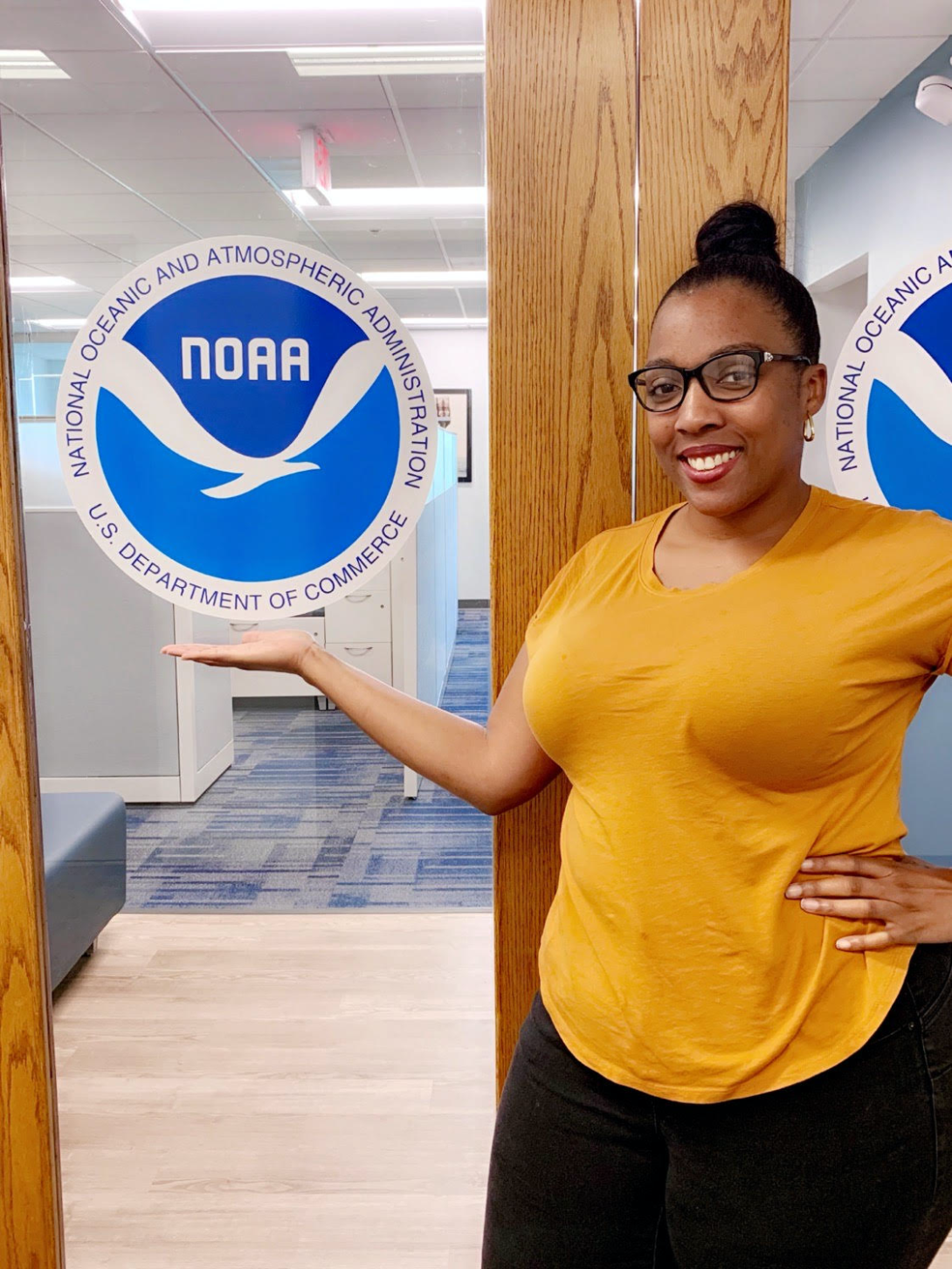IMET Students Complete NOAA Internships
Several IMET students are supported by the National Oceanic and Atmospheric Administration’s Living Marine Resources Cooperative Science Center (NOAA-LMRCSC) program. NOAA-LMRCSC trains graduate students from underrepresented communities in marine science. As part of this program, students complete a NERTO, or NOAA Experiential Research & Training Opportunities. This is an internship at a NOAA facility, which enables students to conduct research in a new place and to better understand the kind of careers available in a federal agency. Recently, three IMET students, and one former IMET intern, completed their NERTO at NOAA facilities across the country. Below are details on the projects they completed.
Shadaesha Green

Shadaesha Green
Lab at IMET: Dr. Sook Chung
NERTO Location: NOAA Chesapeake Bay Office, MD
NERTO Title: Striped Bass Habitat Indicator for Chesapeake Bay
Abstract: The Chesapeake Bay striped bass (Rockfish) is an iconic species. The Chesapeake Bay serves as the largest nursery habitat for Atlantic striped bass. The main objective of this study was to improve the understanding of nursery habitat areas for juvenile striped bass that support survival and recruitment to the adult population. This project was two-fold: (1) develop a conceptual model indicating factors impacting juvenile striped bass nursery habitat and (2) prepare the Chesapeake Bay striped bass nursery habitat assessment’ Request-for-Proposal (RFP) for submission to the Chesapeake Bay Trust. To complete these tasks interviews were conducted with a variety of scientists and fishery managers in the Chesapeake Bay region to gather their insight on factors influencing nursery habitat for juvenile striped bass.
Amanda Lawrence

Lab at IMET: Dr. Sook Chung
NERTO Location: Northwest Fisheries Science Center (NWFSC), Mukilteo Field Station, Ocean Acidification
NERTO Research Project Title: Developing methods to detect the effect of CO2 on the physiology of Dungeness crab
Abstract: Atmospheric CO2 concentrations have increased from approximately 280 parts per million (ppm) to 387 ppm since the start of the industrial revolution (Feely and Doney et al., 2009). Current CO2 concentrations exceed that of levels that have not been observed in over 800,000 years (Luthi et al., 2008). This increased abundance in atmospheric CO2 has resulted in the oceans absorbing approximately one-quarter of anthropogenic CO2 (Sabine and Feely, 2007). This shift in oceanic conditions drives chemical changes that have the potential to leave ecosystems and a range of species at risk. Effects of projected seawater CO2 levels have been shown to alter olfactory-mediated behaviors in the economically and environmentally important Coho salmon (Williams et al., 2019). Gill breathers regulate internal pH through the process of ion transport, which is a process directly influenced by the changing water chemistry. More specifically, near shore benthic ecosystems and calcareous species are predicted to experience some of the more severe impacts regarding a lowering pH (Wootton et al., 2008). Here we will utilize respiration rate to determine the energetic cost of maintaining internal pH in future oceanic conditions, specifically throughout the development of the Dungeness crab, Cancer magister.
Benjamin Frey
IMET affiliation: former intern in the lab of Dr. Rosemary Jagus
Current lab: Dr. Dave Secor at the UMCES Chesapeake Bilogical Laboratory
NERTO Location: NOAA Northeast Fisheries Science Center, Woods Hole, MA
NERTO Title: Validation of age and growth estimates of New England and Mid-Atlantic demersal fishes using microstructural analysis of hardparts
Abstract: Monkfish (Lophius americanus) supports high value fisheries in the Mid-Atlantic and Southern New England. Conservative fishing quotas were imposed owing to refutation of traditional ageing methods that resulted in uncertainties in stock status. Without accurate age interpretation or validation, serious errors in the assessment and management of fish stocks can occur. This internship at the NMFS Northeast Fisheries Science Center (NEFSC) examined the current assessment processes including fishery-independent methods, biological sampling, age determination methods for monkfish and other species (black sea bass, haddock, yellowtail flounder, red hake and silver hake) and age-dependent stock assessment models. I participated in a 2-week leg of the Northeast Fall Bottom Trawl Survey. I trained with the NEFSC Age & Growth group reviewing ageing methods for these species. I met with the assessment leads for each species, reviewing how age-dependent assessments are used in establishing biological reference points and evaluating stock status. My thesis research will continue to involve my NEFSC mentors as I develop novel approaches to age monkfish using trace element micro-constituent analysis of hardparts.
Ammar Hanif

Lab at IMET: Dr. Rosemary Jagus
NERTO Location: NOAA Headquarters, Silver Spring, MD
NERTO Title: Temporal Study of Diet and Microbiome of Mussels Collected from Lake Michigan
Abstract: Two species of invasive dreissenid mussels (Dreissena polymorpha and Dreissena rostriformis bugensis) have successfully established across Europe and North America and have drastically changed resident ecosystems and food webs. Most studies involving these mussels in the Laurentian Great Lakes have focused on organism physiology, distribution, ecological effects, and genetics. This study aims to characterize the microbiome of dreissenid mussel gills, for which limited information is available. The microbiota of mussels is associated with their aquatic habitat and varies with factors such as salinity, bacterial load in the water, temperature, diet and are likely to respond to environmental change. Limited data is available regarding the dreissenid mussel microbiome. The recent development of high-throughput sequencing and metabarcoding has given deeper insights into microbial communities. Preliminary monitoring efforts by the Mussel Watch Program suggest that the dreissenid mussel metabolome may change seasonally. This led to the initiation of a temporal study to address how environmental change affects the mussel gill microbiome and mussel metabolomics. We sampled the microbial community found within the gill tissue of D. r. bugensis collected biweekly or monthly from a single site in Lake Michigan between May and November. The microbial community will be assessed using high-throughput sequencing and metabarcoding. These data will be used determine whether the mussel gill microbiome can be used as a biological indicator of water quality. This study is a collaboration between NOAA’s Mussel Watch program (Great Lakes region) and NOAA’s Great Lakes Environmental Research Laboratory that will augment ongoing studies of mussel physiology and benthic ecology.